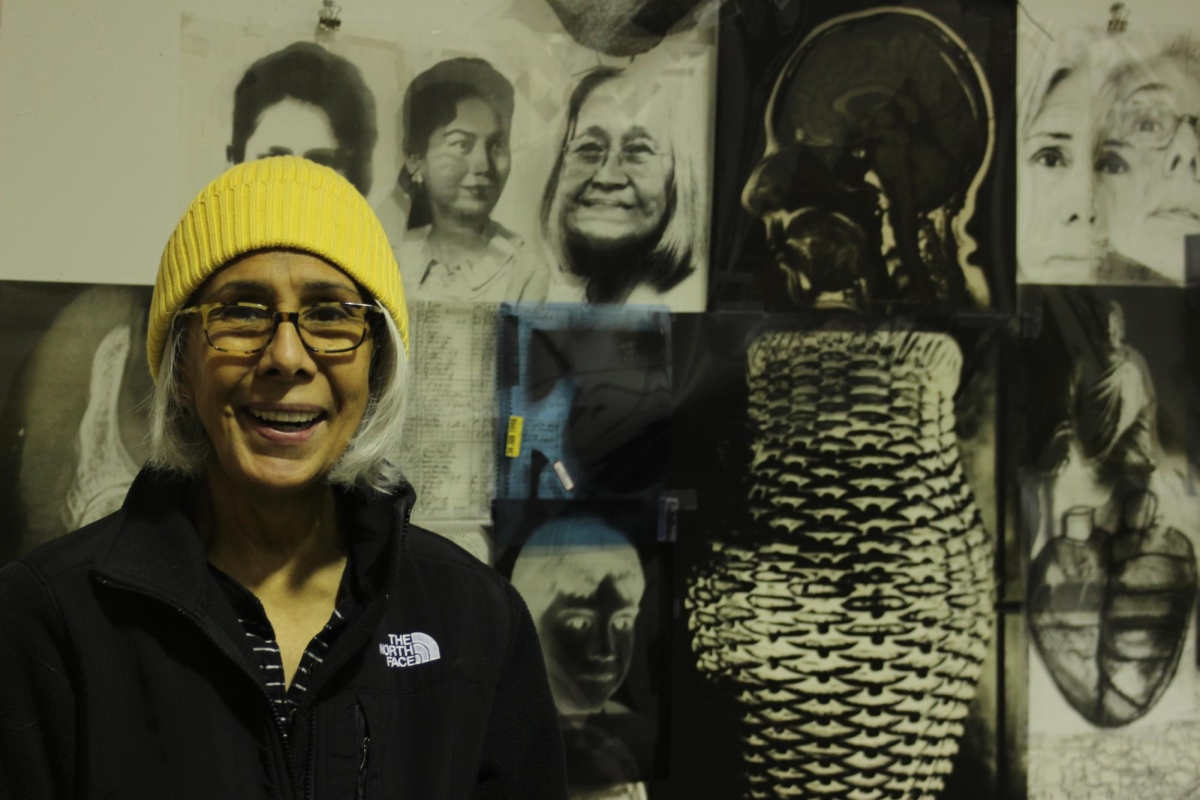In an old military warehouse on Transport Street, a bright orange door is the first thing that greets you. With a little elbow grease and a gentle shove, the door reluctantly opens.
Upon first glance, the building seems quite ordinary, but beyond the entrance lies the extraordinary studio of Palo Alto artist and Bay Area native Terry Acebo Davis.
A nurse turned artist, Davis pulls from her Filipino identity and former career for inspiration.
Her work features those close to her combined with personal scans, including X-ray scans of her body.
In her early years, Davis went to college at California State University, East Bay. Starting as an art major, Davis switched her area of study three times before landing on the one that sparked her passion. Her parents being immigrants, encouraged her to seek a financially independent future so she decided to change paths and pursue nursing.
“Nursing [unlike art] was something that my parents understood,” Davis said. “My parents were immigrants so it’s like, ‘Get a job that can support you.’”
With this in mind, Davis completed her residency at Stanford and continued her nursing career in pediatrics.
During her time as a pediatric nurse, she saw the pain children experience while undergoing chemotherapy treatments through the drawings they made.
This experience allowed her to observe first-hand the expression of one’s feelings through art.
“I studied children’s drawings and their pain and anxiety as they were going through their chemotherapy,” Davis said. “People think that kids don’t feel pain, but [even] babies feel pain.”
After working as a nurse for over 45 years, Davis has seen the dark side of healthcare, witnessing heartbreaking passings of those gone too soon.
With this in mind, she pulls a lot of her creativity and imagination from resembling the tortured artist, one who takes inspiration from the emotional trauma in their lives.
Often seen as a cliche, she defies the negative assumptions placed on artists and defends her source of inspiration. Davis lives by the saying, great art comes from great pain.
“Life happens, and we have to process it in some way,” Davis said. “But when I make art, it becomes something else for my audience.”
When her father suffered a stroke paralyzing half of his body, Davis created a powerful exhibition called “Walk In My Shoes.” A pair of flip flops were the last shoes her father wore. To commemorate him she bronzed both her mom’s and dad’s shoes.
“Sometimes things in life happen and you’re trying to make sense of it,” Davis said. “And that’s where my art comes from.”
Similarly, her exhibition called “Faces,” features portraits of two of her close friends and of her idol, Frida Kahlo.
One of the friends depicted in the exhibition had recently passed away due to stage four terminal cancer and the other narrowly survived after contracting COVID-19.
“If I were dying and I wanted to talk to somebody, who would I want to talk to? And I said, ‘Frida Kahlo,’” Davis said.
Davis’ talent in multiple mediums allows her to express her feelings in various forms.
She experienced firsthand the backbreaking work placed on nurses during the COVID era.
In one piece, Davis uses a collage to illustrate the past, present and future of nursing.
The past is symbolized by photos of Filipino immigrants and pays tribute to nurses of Filipino descent who died during COVID.
The present is represented by a photo of Davis during her time as a nurse and the future features photos of nurses she trained during their residency.
Davis felt it was essential to incorporate her culture into the art she created.
“Some of these nurses [that were Filipino] were discriminated against, and I understood what that was all about,” Davis said. “I was very involved in our union, and I mentored many, many nurses over time.”
After a decades-long career of caring for others, her biggest takeaway has been to view the individual for who they are.
“I’ve taken care of very important politicians, sports figures, actresses, actors, singers — and we all bleed the same color blood,” Davis said.




